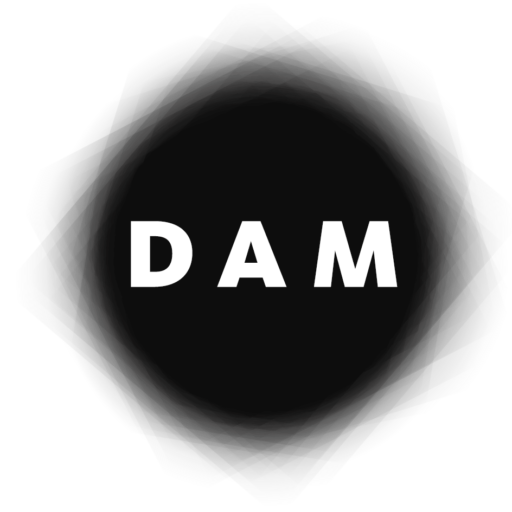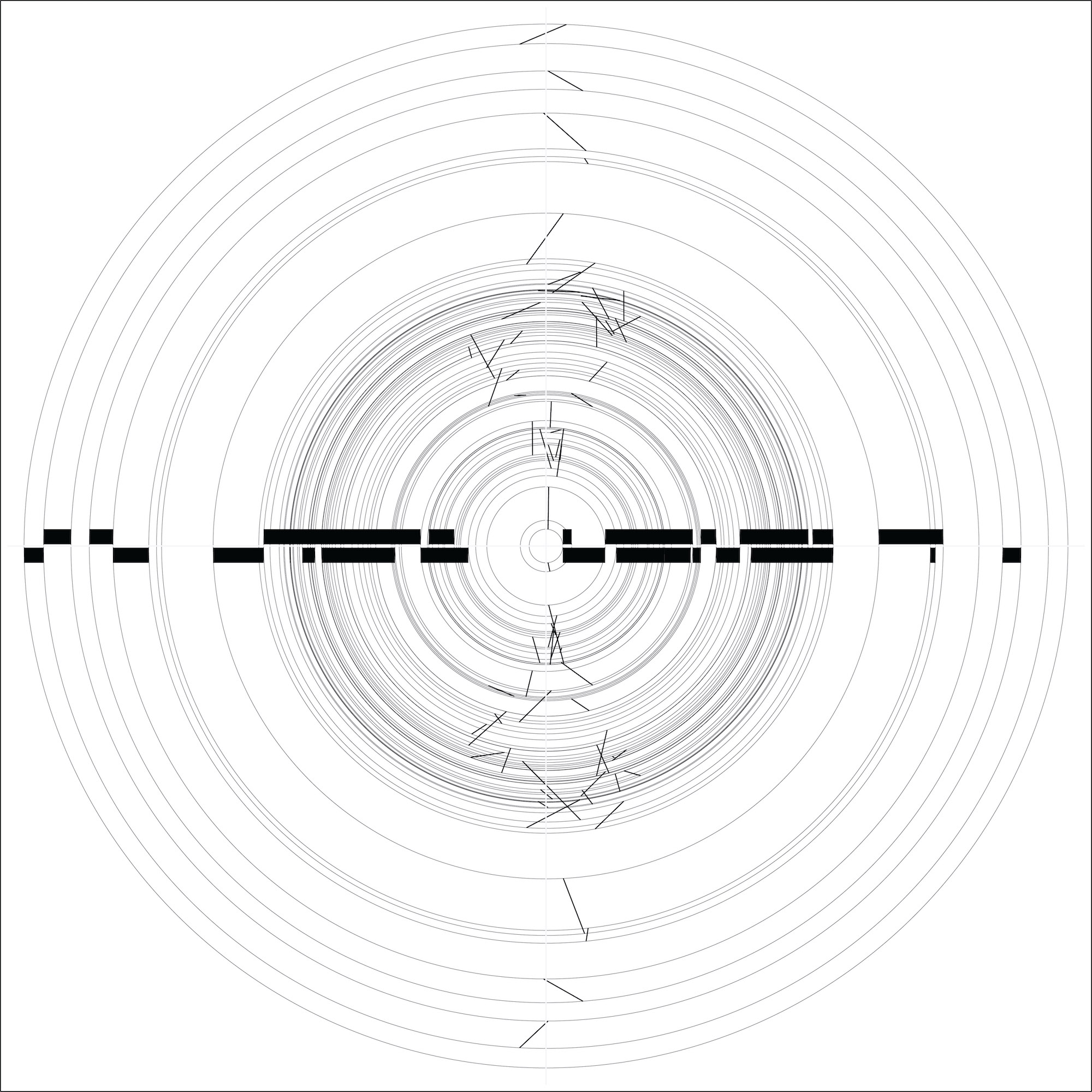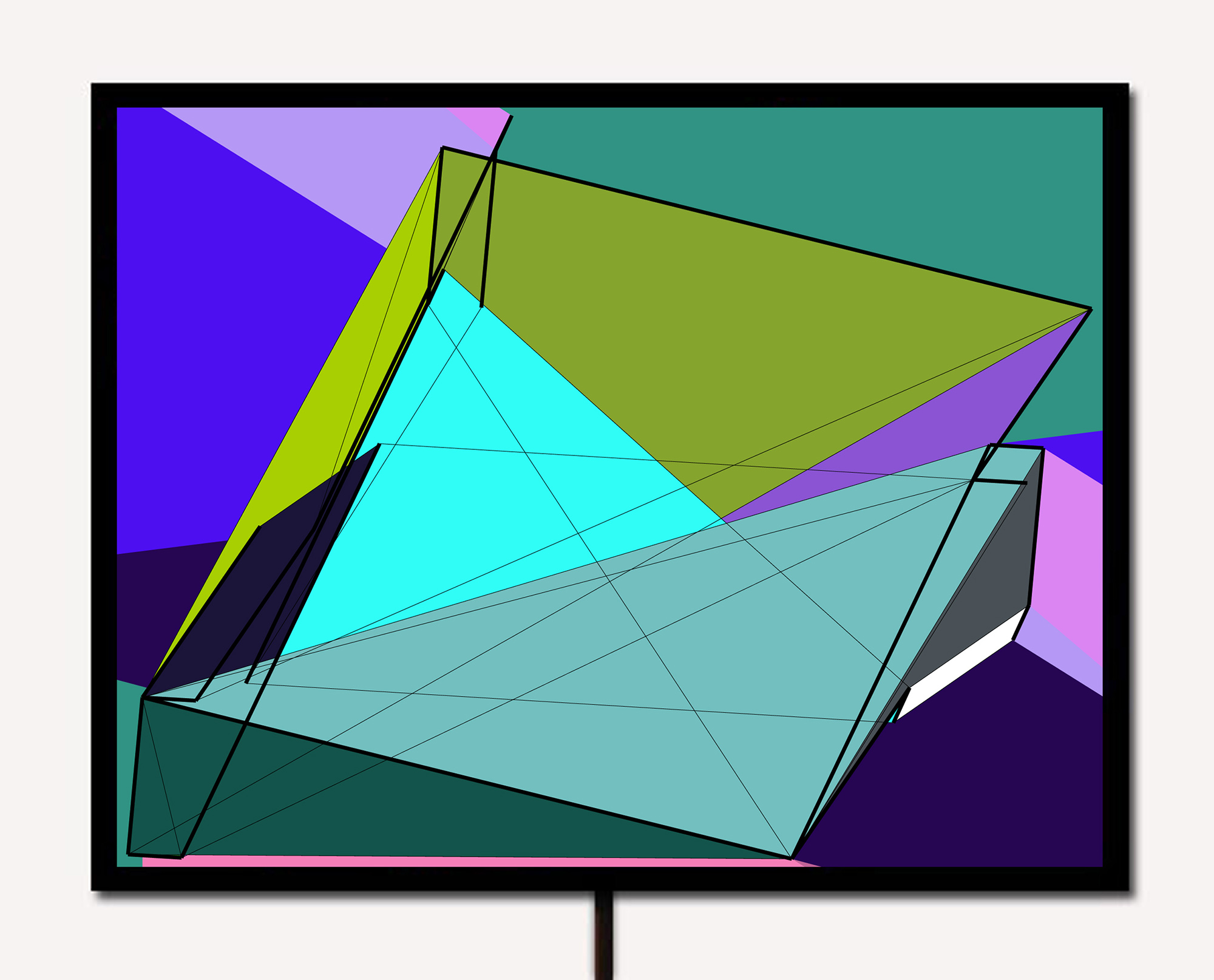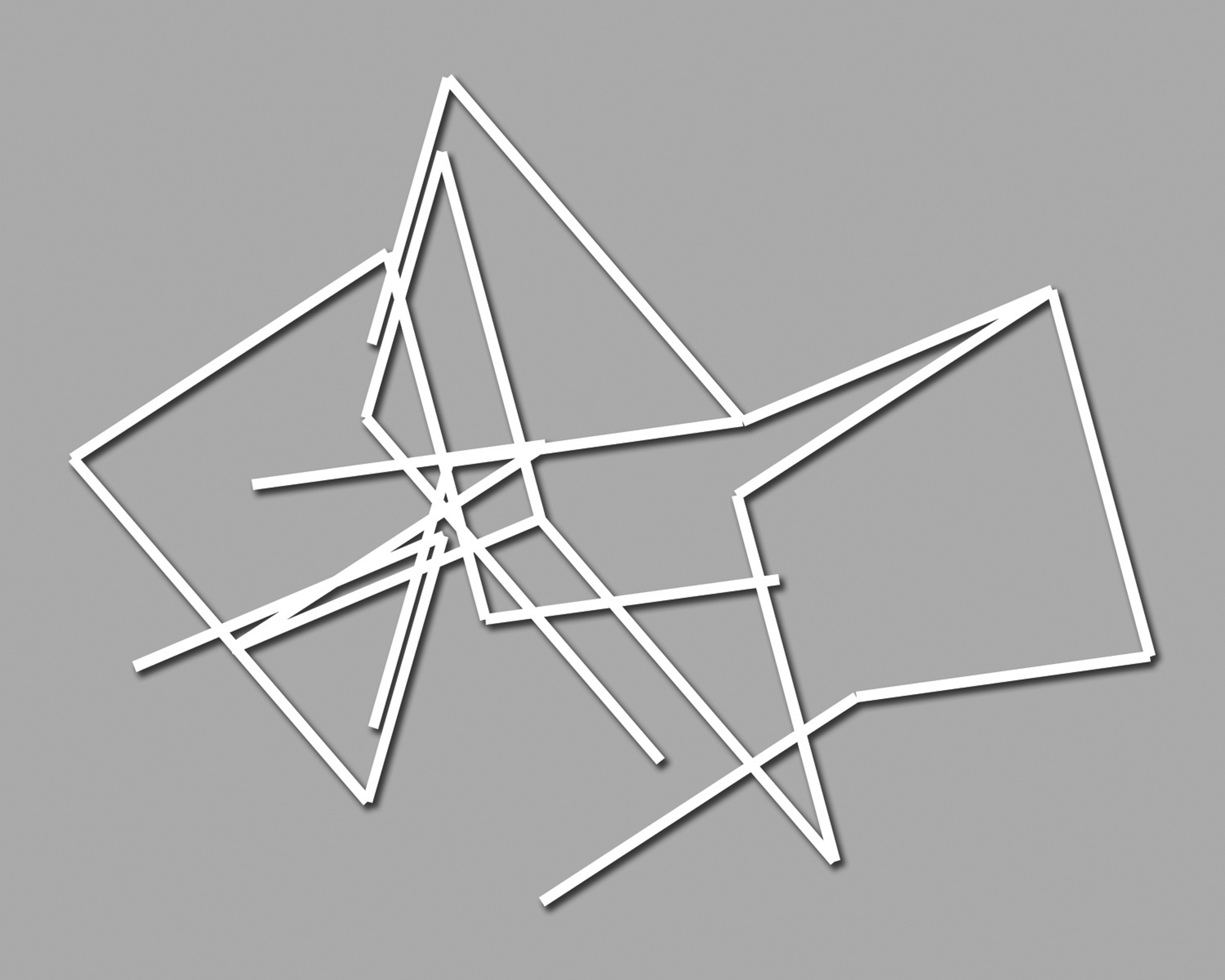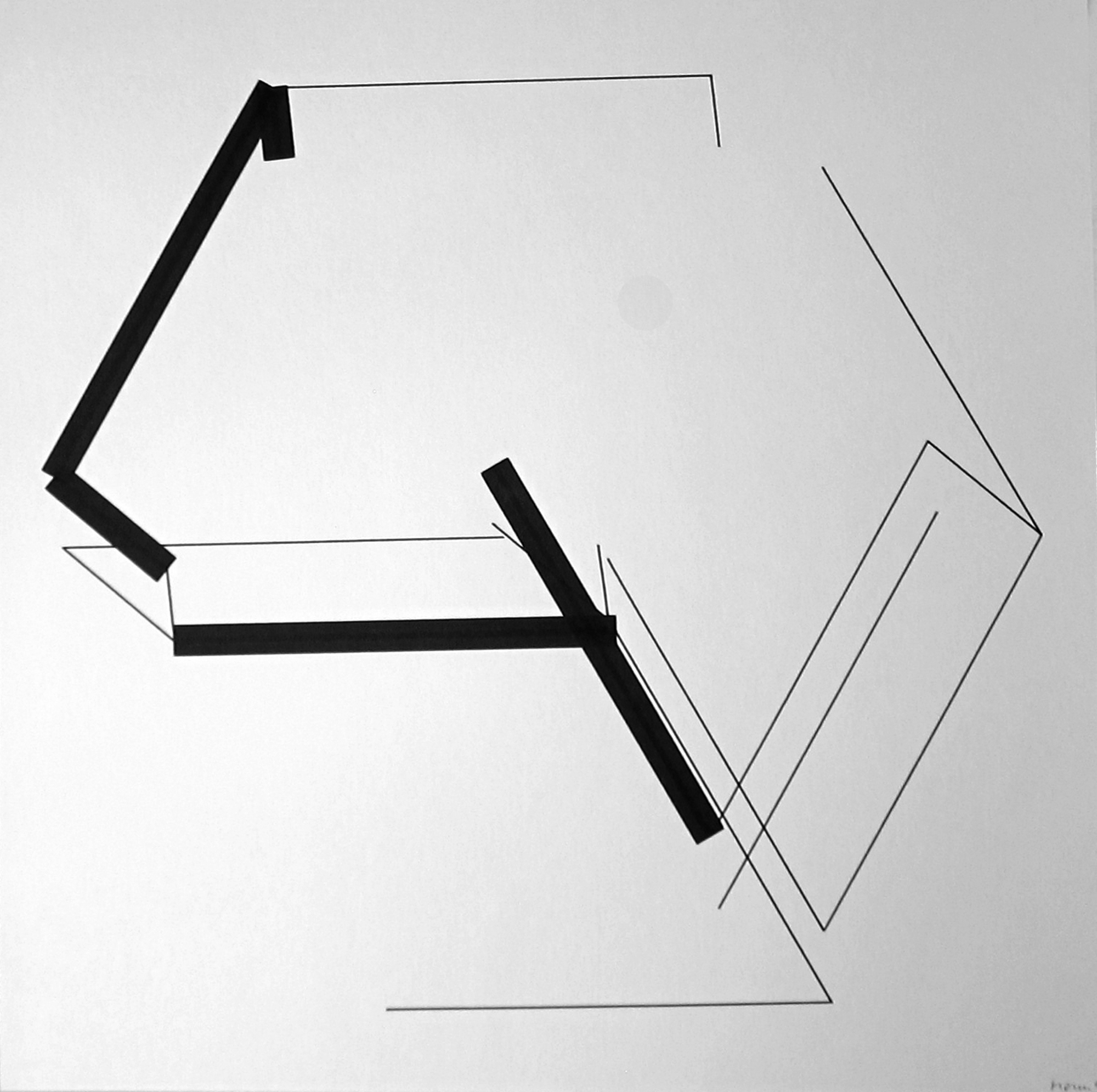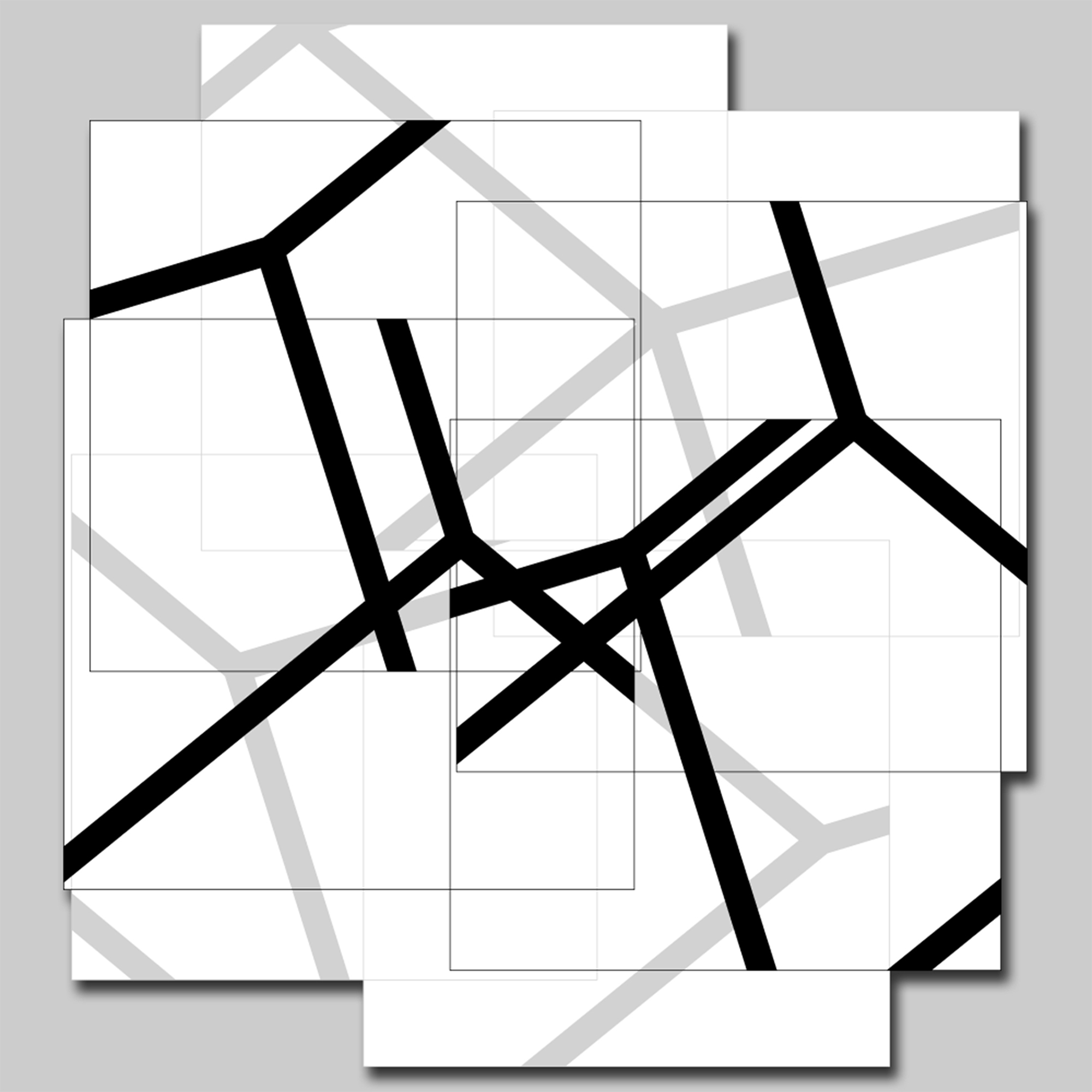algorithmic modulations (2019)
In this series, one randomly chosen diagonal path through a 12-D hypercube is selected and placed in three different angular positions. The diagonal-paths become visible as transparent color bands. A thin horizontal black line is drawn starting from each vertex (of all three diagonal paths), crossing the vertical center of the image and continuing to the opposite side. In addition, for each vertex a slightly thicker horizontal black line is drawn starting from the vertical center of the image and continuing to the negative x-value of the respective vertex (reflection from the vertical center). The music related horizontal lines were initially used in Artificiata I, 1969 and then again on numerous occasions.
Transit-Code (2017-2018)
In his search for visualizing his artistic ideas writing code, Mohr has occasionally rewritten or abandoned an algorithm that was not successful, then worked on them again at a later date. In the P2300 series from 2017, he used the same algorithm from the work series P1680 (2014), which consists of an n-dimensional diagonal-path divided into its even and odd segments. In the P2300 series, each square is bent 180 degrees and rotated, generating a circular form.
Artificiata II (2012-2015)
This series is named after Mohr’s first visual artist book, Artificiata (1969), which was also his last hand-drawn artwork. At the time, he imagined a second version of this work which would be based on algorithms and calculated and drawn by computer, and 44 years later he created a second visual book that rendered his initial ideas in algorithmic drawings. The series comprises four parts: baseline – artificiata II (2012 – 2013), traces – capturing the history of n-dimensional rotations (2014 – 2015), projections and dimensions (2013 – 2014), and parity – fracturing n-dimensional diagonal paths (2014 – 2015).
parallelResonance (2009-2011)
Inspired by his exploration of a “surrealistic geometry” in the mid 1960s, which consisted in exploring the tension fields created by the voids between geometric elements in a visual composition, Mohr develops the same principle in this series through an algorithm. Here, two randomly selected and superimposed 11-dimensional diagonal-paths describe white and black forms, projected on a colored background. At times, the black form interchanges its color with the background to further create new visual relatins in form and tension fields.
klangfarben (2006-2007)
Following a logic inspired by the rules of “serial music,” Mohr explores the 40 billion possible diagonal paths in an 11-d hypercube using four sets of eleven diagonal paths rendered with three different line widths, created by a custom software written by the artist. This process is shown on two square LCD screens, one displaying 2 to 10 diagonal paths rotating in slow motion, while the other depicts a fixed composition. The screens are placed in a 90 degree angle to encourage the viewer to observe either one or the other.
subsets.motion (2003-2005)
Using the same computer program as subsets (2003), a series of self-built computers execute the 11-D animation program with each installation using a unique set of parameters which determines the sub-structure. Each time the program is restarted it picks a new set of 11-d random angles and increments (based on the present time and date), which results in unique images.
subsets (2003-2005)
‘Subsets’ is a work phase based on the 11-d hyper-cube. The algorithm written by the artist selects a subset of cubes from a repertoire of 42240 cubes inherent to the 11-d hyper-cube and decides which sides shall be black or white. Clipped by a defined window, this structure rotates in front of a green background. Since the above mentioned subset is by definition incomplete, the green background occasionally becomes visible, as the structure is rotating in 11-dimensions. Mohr describes this system as “visual music,” inspired by his passion for action painting and free jazz.
space.color.motion (2002-2004)
This series is based on the same computer program as space.color (written in 1999), which is run on self-built computers. The program executes a 6-D animation with each installation using a unique set of parameters which determines the sub-structure and color set. Each time the program is restarted it picks a new set of 6-d random angles and increments (based on the present time and date), resulting in unique compositions.
space.color (1999-2003)
In this work phase, Mohr introduces color for the first time, after working for more than three decades in black and white. The use of color responded to the increasing complexity of his work, which forced him to look for a visual expression that went beyond the binary system of white and black. The colors, however, are not meant to convey a meaning in themselves, but rather used randomly to highlight the spatial ambiguity of the compositions. The algorithm is based on the 6-dimensional hypercube, which allows to draw 720 different diagonal paths, from which four are selected each time and drawn with thick lines, their vector connected with thin lines. The connecting lines form planar structures with randomly assigned colors.
Half Planes (1995-1998)
This work phase is based on the 6-D hypercube. As indicated for the “Laserglyphs” (1991), this complex structure has 32 diagonals from which 23040 “diagonal-paths” can be calculated combinatorially. A random selection of two “diagonal-paths” from this alphabet of signs provides the building blocks for each work. In the grey paintings, the “diagonal-paths” are represented by thick white lines. The vector pairs which complete the quadrilaterals are represented by thin black lines. The quadrilaterals are colored in grey to create the shape of the painting. In the drawings, the “diagonal-paths” are represented by thick black lines and the vector pairs are represented by thin black lines. In the metal reliefs, the art-work is composed of 3 bent flat metal strips. The strip representing the contour is painted white, and the 2 strips representing the “diagonal-paths” are painted grey and black respectively.
Counterpoint (1993-1995)
In this series, two diagonal-paths (through the 6-D hyper-cube) are chosen in the way described in “Laserglyphs”. Each work consists of one thin black line and one thick grey line drawn on canvas. The line width is inversely proportional to the decrease in color intensity from black to grey. To visually maintain the inherent connectivity only such lines can be chosen which have at least one common point in the structure. Both lines have a visual relationship comparable to the counterpoint of a succession of sounds in music. For each work, the picture format is a result of the size and location of the two diagonal-paths in relationship to one another.
Laserglyphs (1990-1993)
Mohr works in this series with the 6-dimensional hyper-cube, a structure that has 32 diagonals and 720 different “diagonal-paths”. For each “Laserglyph” a random selection of four “diagonal-paths” from this repertoire of 23040 (32×720) possible paths is made. The 2-D dimensional projection of such groups of four are cut out of a metal plate by a laser to form a relief. Each of the drawings show the 720 diagonal-paths between between 2 diagonally opposite points in the 6-D structure.
Line cluster (1989-1990)
The chosen geometric structure in this series is the 5-dimensional Hyper-cube, which is built from a set of eighty lines. A subset of twenty lines, containing four lines from each “dimensional-direction” are chosen from this structure. Each “dimensional-direction” consists therefore of four parallel lines, represented by three thin lines and one thick line (drawn in a given 5-dimensional rotation).
Dimensions II (1986-1989)
In this work phase, the four-dimensional rotation of a hyper-cube becomes an additional element in generating signs and shapes. A four-dimensional hyper-cube can also be seen as a structural relationship of eight interconnected cubes. In this particular work, each of these eight cubes are looked at through a square window (the 0,0,0 rotation of each cube). Four of the cubes are represented by their frontal view (black) and four by their back (grey). This partitioning of black or grey is a combinatorial element in the algorithm of this work.
Divisibility II + III (1984-1986)
In the second part of this work phase, a molecular-like growth is created with the “four-cut” as its seed. Growth results from algorithms of graph patterns deciding which “out-lines” of the quadrants created in the preceding generation is used to produce the “four-cut” of the next generation. In a third part, the contours of the “four-cut” is seen as a “shadow-form”, a two dimensional visual history of the cube-growth. The connecting path between the center point of one “four-cut” and the center point of the next “four-cut” is shown as a black line, the growth-line. Similar to the spine in a body, the growth-line is embedded in the shadow-form.
Divisibility I (1980-1984)
In “Divisibility”, the cube is used again as a fixed structure to generate signs. The cube is divided into four sections by a horizontal and a vertical cut. Four independent rotations of a cube are projected onto the corresponding quadrants created by the cut. In order to visually stabilize the structure, two diagonally opposed quadrants (top right and bottom left), contain the same rotation. In the first part of this work phase, the “four-cut” is the basic structure with which the “out-lines” form shapes and the “in-lines” form signs.
Dimensions I (1977-1979)
In this series, the graph of a four-dimensional hyper-cube is the basic generator of signs. This graph is a two-dimensional representation of the hyper-cube, indicating relationships between points, lines, squares and cubes, inherent in this structure. A global structure is generated either by combinatorially selecting lines from the cube or by showing connecting paths between 2 given diagonally opposite points on the graph (diagonals). A 4-d hyper-cube has 8 pairs of diagonally opposite points. A “diagonal-path” is the connection of 2 such diametric points through the network of edges of this complex structure (there are 24 “diagonal-paths” for each of the 8 diagonals).
Cubic limit II (1976-1977)
In the second part of this series, cubes are divided into two parts by one of the Cartesian planes. For each image the two partitions contain independent rotations of a cube. They are projected into two dimensions and clipped by a square window (the projection of a cube at 0,0,0 degrees). By rotating both parts of these cubes in small but different increments, long sequences of images are developed.
Cubic limit I (1973-1976)
In “Cubic Limit”, Mohr introduces the cube into his work as a fixed system with which signs are generated. In the first part of this series, an alphabet of signs is created from the twelve lines of a cube. In some works, statistics and rotation are used in the algorithm to generate signs. In others, combinatorial, logical and additive operators generate the global and local structures of the images.
Early algorithms (1969-1973)
During these years, Mohr introduces into his work a logical and automatic construction of pictures, using algorithms for the first time. The artist writes computer programs and obtains drawings realized by a computer controlled drawing machine (plotter). With a choice of different line characteristics, an alphabet of arbitrary generated elements is created. Individual algorithms are invented for each work from which all forms and structures are solely generated. The algorithms are built from imposed as well as from random selection principles which the artist called “aesthetical-filters”.
Hard edge (1966-1969)
This work phase (1966-69) introduces geometry and constructibility (but not yet the computer) into Mohr’s work. In a subjective selection process, geometric elements influenced by electronic and other technical signs are created and distributed over the entire pictorial surface. They are mobile signs, that means, they are exchangeable signs. Since all signs (forms) are surrounded by a pictorial force, they create in their juxtaposition a network of abstract visual tension.
Early work (1960-1966)
Mohr’s early artistic work was influenced by atonal music, modern Jazz and abstract expressionism. The art of K.H. Sonderborg gave him a profound visual guidance and the understanding of Max Bense’s philosophy a unique direction. As a consequence, geometry and the reduction of his visual vocabulary to black and white as binary decisions, took more and more importance in his work after 1963.
